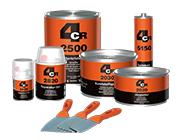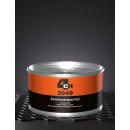Metal putty - zinc putty

Metal body putty - Zinc body putty
︾
Description of the metal putty - zinc putty available on the Carross website:
Metal putty (and zinc putty) is a putty suitable for both metal and zinc. Carross offers you high-quality two-component putties. This type of putty is easy to sand for precise work on bodywork surfaces! Even though metal zinc putty goes by this name, it adheres more generally to a wide range of substrates: steel, iron, zinc, aluminium and even Fiberglass-reinforced plastics (FRP). One of the advantages of zinc metal putty is that it is vertically stable, easy to apply and, when sanded, emits very little dust, which is good for the bodybuilder's health! Zinc metal putty dries quickly and has excellent adhesion to its substrate. It also has excellent resistance to bending. Putty is also resistant to petrol, diesel and certain acids. If you want excellent anti-corrosion protection, 4CR 7515 is excellent: this putty protects iron and steel particularly well. What's more, it's temperature-resistant up to 300°C!
Adhesion to metal:
Tin Metal Body Putty is specially formulated to adhere strongly to metal surfaces, making it an ideal choice for body repairs on metal panels.
Flexibility:
It offers a degree of flexibility once cured, allowing the Putty to withstand bodywork movement and vibration without cracking.
Ease of application:
Tin Metal Putty is generally easy to apply with a spatula, effectively filling small cracks, holes, or surface irregularities.
Fast curing:
This type of Putty often has a relatively short curing time, allowing for quick and effective repairs. This can be advantageous as part of a bodywork repair process.
Easy sanding:
After curing, tin metal putty can be easily sanded to a smooth, even surface. This makes it easier to prepare the area for painting.
Paint compatibility:
Putty is generally compatible with the primers and paints used in the bodywork repair process. It gives an attractive, long-lasting finish.
Corrosion resistance:
Some tin metal putties have anti-corrosion properties, helping to protect the repaired metal surface from rust formation.
Versatility:
As well as being used on car bodies, tin metal putty can also be used to repair metal objects such as furniture parts, tools, and other metal surfaces.
Dimensional stability :
After curing, tin metal putty has high dimensional stability, meaning it retains its shape and does not shrink excessively over time.
It is important to note that the effectiveness of tin metal putty also depends on how it is applied and the quality of the product used. It is advisable to follow the manufacturer's instructions for the best results when carrying out bodywork repairs.
Frequently asked questions about using tin metal body filler:
Tin metal putty is an essential tool in the car body repair industry for restoring damaged metal surfaces. Here are some of the questions frequently asked by users, with professional answers to guide optimal use:
1. How do I apply tin metal putty correctly to a car body?
To apply Putty, start by preparing the surface by cleaning and degreasing. Use a spatula to spread the Putty evenly over the areas to be repaired. Make sure that any cracks or irregularities are properly filled. After curing, sand the surface to a smooth finish before applying primer and paint.
2. How long does it take for tin metal putty to harden completely?
The curing time for tin metal putty depends on the specific product you use. In general, it can vary from a few minutes to an hour. Consult the manufacturer's instructions for precise information on curing time and make sure you respect these times to obtain the best results.
3. Can Putty be applied to non-metal surfaces?
Putty is specifically designed to adhere to metal surfaces. Its adhesion may be less effective on other materials. For non-metallic surfaces, we recommend using products specifically formulated for these materials.
4. Do I need to use a primer after applying tin metal putty?
Yes, the use of a primer after the application of tin metal putty is recommended. The primer helps to ensure better adhesion of the paint, offers extra protection against corrosion, and helps to even out the surface for an aesthetically pleasing finish.
5. Can I paint directly on the tin metal putty without using a primer?
Although some paints can adhere to tin metal putty, the use of a primer is strongly recommended. The primer prepares the surface optimally, improves paint adhesion and helps prevent potential problems such as colour variations.
6. Is tin metal putty corrosion-resistant?
Some tin metal putties have anti-corrosion properties. However, it is important to check the specifications of the product you are using. In all cases, the application of a quality primer and paint will also help to protect the surface against corrosion.
In conclusion:
Tin metal putty is an invaluable ally in metal bodywork repairs. By following the correct application steps, respecting curing times, and using complementary products such as primer, users can achieve professional, long-lasting results.
